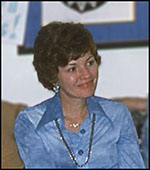
Martha Bracken (Dec. 11, 1934–Aug. 3, 2018; née Martha Ella Dobarzynski) was the wife of a U.S. naval officer and diplomat, as well as a caring daughter, sister, mother and aunt.

The daughter of Martha Hester Ryals (Sept. 10, 1906–Jan. 28, 1999) and Walter Ignatius Dobarzynski (June 27, 1900–May 8, 1972), Martha Bracken was born in Century, Florida—her mother’s hometown, where her grandfather was the successful owner of a general store and his brothers were property-owning farmers.
Walter Dobarzynski was the son of Polish immigrants who returned to their homeland after having a boy and girl in the United States. Walter and his sister were left behind and raised in an orphanage in Newark, New Jersey. Dobarzynski left the Catholic shelter in 1919 and joined the U.S. Navy. He was stationed in Pensacola, Florida, when he began courting Martha Ryals—the two were married the same day she graduated from high school, May 6, 1927.
Soon after Martha Bracken was born, she and her mother went to Pensacola, where the family, including her two older brothers, lived for a couple of years until they moved to National City, California. Martha would take ballet, gymnastics and tap dancing lessons in the Golden State as treatment for a knee condition, and, she recalls, her mother would sew her clothes using a pedal-driven sewing machine. Martha was a pretty girl with auburn hair and hazel eyes.
While on assignment in Hawaii, the aircraft on which her father served, a Consolidated PBY Catalina seaplane, was flying low and crashed into the beach. He survived, but his back was badly injured, and this would be a source of pain throughout the rest of his life. Walter was no longer able to fly.
He was transferred to Oregon as a radioman, and while the family was making the trip north up the coast, crossing the Golden Gate Bridge on December 7, 1941, they heard news on the radio that Japan had attacked Pearl Harbor. As soon as they crossed the bridge, they got off the road so her father could check in and find out what was happening and where he should go.
Martha recalled that while they were in Astoria, Oregon, the windows of their motel rooms were covered with black paper because of the threat of Japanese aerial bombardments. A schoolteacher lived in the same motel and gave Martha, then in the first grade, a ride to school every morning. The family only stayed in Astoria for a couple of months, as her father was transferred to Jacksonville, Florida, to escape Oregon’s cold, damp climate, which aggravated his back condition.
The family lived in a Jacksonville military project until Walter retired in 1944 as a chief aviation machinist mate. Martha completed first grade and the rest of her grammar school education at Fishweir Elementary School, where she met her lifelong friend JoAnn Clark (later JoAnn Troxler).
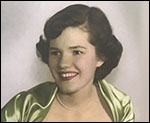
The family bought a house in the Murray Hill section of Jacksonville, and while living there, Martha attended John Gorrie Junior High School and Robert E. Lee High School, where she was a member of the National Honor Society. She had grown up to be a slender five feet, eight inches tall.
After graduating from high school in 1952, Martha and JoAnn went to South Georgia College in Douglas, Georgia. A photo album from this time shows that this school was a nice fit for Martha and she had many friends. During the summer, after the first year, Martha worked for an architect, running his blueprint machine, and she went back to school in the fall of 1953, but had to drop out because of money problems.
She moved back home to Jacksonville, and in March 1954 she began working for Prudential Insurance Company. With her earnings, she bought a car that she shared with her mother while Martha was working—her mother would drive her to the bus stop and Martha rode the bus over the St. Johns River to the Southside neighborhood. The car gave her mother her first real sense of independence.
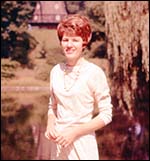
Martha attended night classes at Jacksonville University while working at Prudential, saving money to go back to school full time. She left Prudential in January 1958, and later that year she met Tony Bracken (Leonard Anthony Bracken, Jr.; 1933–2018) at a house party after a dance at the Naval Air Station. He didn’t hear much of her voice that night but would soon be smitten by her slightly drawn-out pronunciation and circuitous storytelling.
Starting in the summer of 1958, she enrolled at the University of Florida in Gainesville, living off-campus with five other young women in a large house, and going back to Jacksonville on weekends to see Tony, a navy pilot who was staying in bachelor’s quarters on the airbase when he was not on deployments to Morocco and Spain, which included side missions to Greece and Malta.
Tony, who noted he was attracted to Martha’s intelligence as much as her beauty, said he proposed by phone after he had been given orders to move to Norfolk, Virginia, to fly carrier planes. Martha, late in life, did not recall that detail of the proposal. They were married in May 1959 at Saint Edward’s Catholic Chapel on Naval Air Station Jacksonville with JoAnn serving as maid of honor and Bill Bracken, Tony’s brother, serving as the best man. Martha is graceful in the wedding photos, wearing a bright smile along with her white dress.
The newlywed couple took Tony’s turquoise four-door Plymouth Savoy to St. Simons Island in Georgia and honeymooned at the King and Prince Hotel.
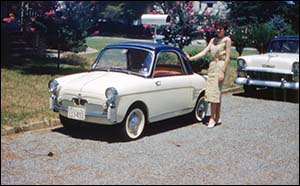
After the honeymoon, Martha joined Tony in a furnished house not far from the base in Norfolk. Martha returned to Jacksonville in September 1959 to practice teaching, but the school lacked resources and it wasn’t a good experience for her. During this time Tony lived in bachelor’s quarters. When she returned to Norfolk, the couple moved into an apartment in Ward’s Corner, which at that time was known as the “Times Square of the South” because of its strip shopping malls, and he bought her a little Autobianchi Bianchina. Martha’s charm and hospitality were key elements to the success of parties hosted by the couple in the apartment.
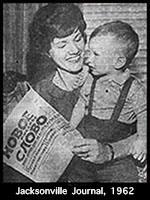
Martha became pregnant in April 1960 while she and Tony still lived in Norfolk, and not long after moved to Marlo Heights, Maryland, driving both cars north. Tony had been assigned to intelligence school in Washington, D.C., in part because the Norfolk parties were noted by his superiors as making the couple apt for diplomatic posts. Martha went into the hospital at Andrews Air Force Base in early 1961 and gave birth to a son who went by Len after his paternal grandfather.
The same year Tony received orders to work at the U.S. embassy in Moscow as the assistant naval attaché and began Russian language training. Martha would also study the language, although she was primarily concerned with preparing for the move with the help of her parents. A 1962 article in the Jacksonville Journal, written during a visit home, describes Martha’s plans for packing canned food and warm clothing. The accompanying photograph shows her smiling with her son on her knee and a Russian newspaper in hand.
The family flew in May from New York to London, where they would stay in the Marylebone section of the city for a month. Martha was assisted in childcare at that time by a young British nanny. It was later revealed that the older woman who rented apartments to the U.S. military while they were undergoing further attaché training in London had been a Russian spy.
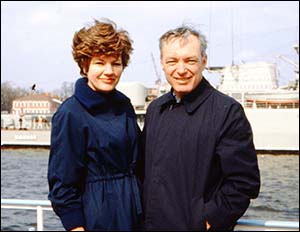
In Portsmouth, the family boarded a Soviet ship that took them to Stockholm and to Riga before arriving in the port of Leningrad—from there they flew to Moscow, arriving in late June, where they would live for the next two years at 45 Leninsky Prospect. It was the height of the Cold War. Martha recalls that CIA pilot Gary Powers was still there, in a Moscow prison, when they arrived and that the Cuban Missile Crisis took place soon thereafter.
An elderly Finnish woman, Taimi Himlova, who had worked as a nanny at the presidential palace in Helsinki, lived with the Brackens, taking care of Len. This enabled Martha to travel extensively during this time—in addition to her trips within the U.S.S.R., when she would often assist her husband in his information-gathering activities, she went to Germany and Austria in March 1963; to Hungary, Italy, Greece and Turkey in October 1963; to Finland, Sweden, the Netherlands and France in April 1964.

Martha spoke Russian and had a deep appreciation for the culture, particularly hand-embroidered Russian folk costumes and miniature paintings on lacquer boxes, which she collected. She purchased original works of art during this first tour and would add to her collection during a second tour in the late seventies. Martha sought out works that captured Moscow during the times she lived there or were classically Russian, according to a connoisseur who has seen the collection.
A charcoal drawing by Vladimir Minaev (Владимир Николаевич Минаев 1912–1993) of “Ulanova in the role of Juliet,” referring to the ballet dancer Galina Ulanova, reflected the charm of Moscow in the sixties, as did the work “Samovar” using various soft materials by Oleg Ivanovic Grosse (Олег Иванович Гроссе 1932–1991). Minaev and Grosse are probably the most well-known artists in Martha’s collection.
An oil painting on wood by Gennady Solovykh (Геннадий Соловьıх 1932–2011) of “Saint Basil’s Cathedral” and the surrounding Red Square illustrates the innovative perspectives that were being attempted by Moscow artists in the late seventies. The most poetic rendering of the Kremlin in the collection, however, is the 1944 oil painting of fireworks exploding over the Spasskaya Tower by Pyotr Korostelyov (Пётр Гурьевич Коростелёв), who was born in 1924 and died in 2017—the artist wrote that the canvas was given to Boris Vasilevich Shmitko on December 31 of the year it was painted.
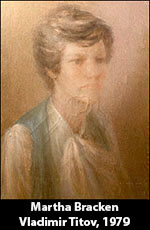
Through her patronage in 1978–79 of Lydia Georgieva (Лидия Георгиева), several of whose snowflake paintings are in the collection, Martha met two members of the Nonconformist Art Movement: Dmitri Plavinski (Дмитрий Петрович Плавинский 1937–2012) and Vladimir Titov (Владимир Титов 1950).
Plavinski, like Georgieva, was inspired by the increased activity that was taking place in Orthodox churches at the time, which Martha was pleased to witness first hand during large celebratory masses at Easter and Christmas. Martha’s collection includes a lithograph by Plavinski of a sword-wielding knight on horseback and several of his large-format black and white photographs of the monastery in Sergiyev Posad outside Moscow.
Titov, who would eventually immigrate to France, captured the vast Russian steppe in soft hues with chalk-white accents in a large rectangular painting that is part of the collection. He would go on to use much the same softly blended colors that Martha liked so much in an impressionistic portrait of her in 1979. She was disappointed by a crease in the canvass that nonetheless lyrically captured her countenance at the time.
Two very old paintings are hard to identify. One is a watercolor of roses signed by M. Shmelev (М. Шмелёв) bearing the seal of the Russian Empire and stamped 1914, indicating that it could not be the soviet-era painter with the same name who was born after that year. The other is an oil painting made on canvas that an expert, upon seeing the reverse side, said must date to the 19th century: an impressionistic landscape, likely executed en plein-air, looking from edge of a forest into an open field with people strolling by in the foreground and country houses in the background—the painting is signed but the signature can’t be fully deciphered (it appears to read: Третьяко or, in English, Tretyako).
The collection also includes a large 1994 oil painting by Alexander Pavlovich Zhdanov (Александр Павлович Жданов 1938–2006) from his Washington years. Zhdanov’s earlier works were shown at the 1990 “Other Art” exhibition at the Tretyakov Gallery.
This description of the collection would not be complete without mentioning two unsigned paintings, four pre-revolutionary icons and eight Soviet-era Palekh boxes, as well as several stretched canvas reproductions of paintings exposed in or held by the Tretyakov Gallery, such as “Willow Blossoms” by Sergei Gerasimov (Сергей Герасимов) and the famous “Alyonushka” by Viktor Vasnetsov (Виктор Васнецов), which is now connected with the eponymous fairytale.
Martha also collected tea ware from the Leningrad Porcelain Factory, as well as handwoven textiles, such as Russian linens and rugs from Dagestan.
After the family returned from Russia the first time, Martha obtained her bachelor’s degree in education from the University of Florida in December 1964. The family lived in Rhode Island and California, as well as Athens, Greece, and again Northern Virginia during Tony’s tours of duty. Martha took the role of military spouse seriously and assumed leadership positions within the wives’ groups that were so important when Tony’s squadrons were on cruises.
During his retirement the couple spent a decade in New Bedford, Massachusetts—where Martha studied textile design at the nearby state university while Tony pursued his second career—before returning to Virginia.
During her final decades, she was involved in church and neighborhood women’s clubs. She was also an avid bridge player. When reflecting back on her 83 years, however, Martha would always say that the two tours of Moscow were the highlights of her life. Certainly the role of a diplomatic spouse for the most powerful country in the world gave her a sense of pride, yet she also felt deeply enriched by her contact with Russian culture and liked to surround herself with related objects right up to her final days.